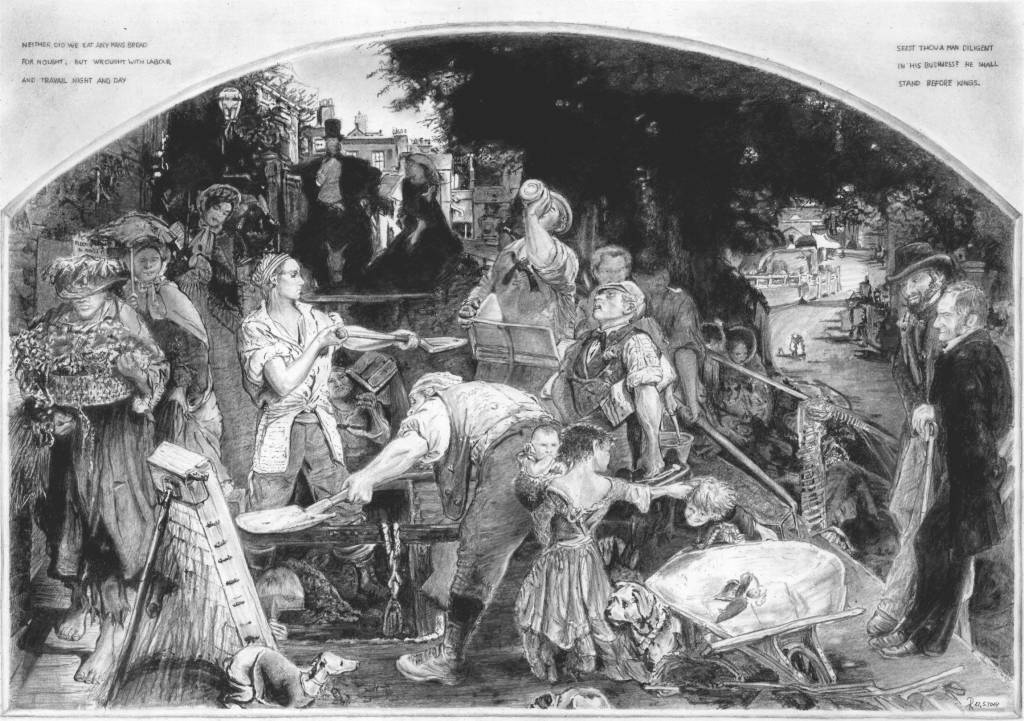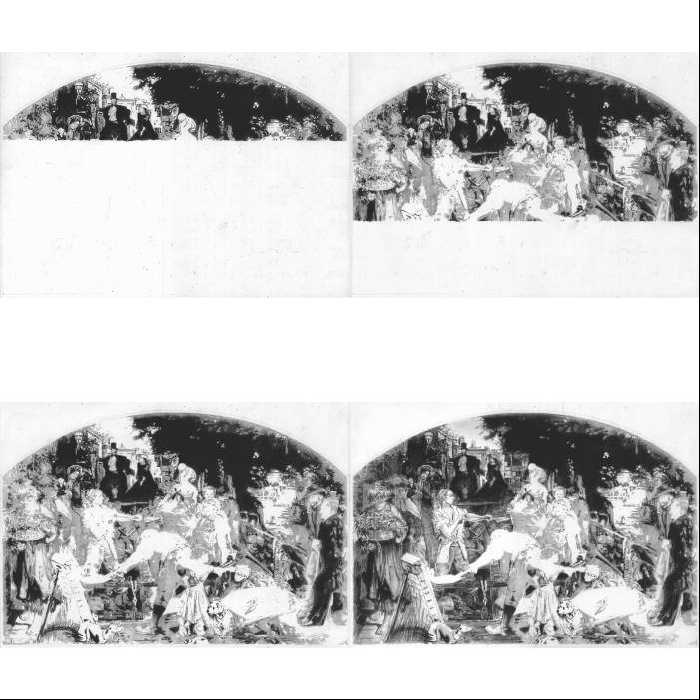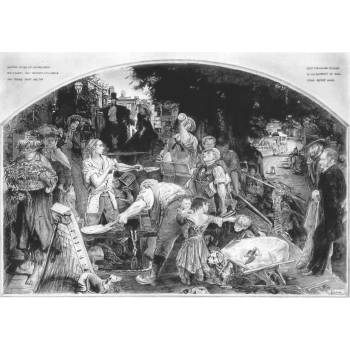Pencil drawing by PencilHB |
D E U T S C H | E N G L I S H |
Famous painting - Madox-Brown
|
Share this drawing |
|
|

May.12.2014 DIN-A3 16.5 x 11.7 inch
Description
ATTENTION
This drawing is not easy to understand. I had to look at the colored original for some time, before I halfway understood the content.
So be patient...
(if you don’t understand the drawing, read the text below, there is a description)
About the original painting
Artist | Ford Madox Brown (1821–1893) |
Title | 'Work' |
date | 1865 |
Period | Pre-Raphaelitism |
Technology | Oil on canvas |
Dimensions | 137 cm × 198 cm (53.9 in × 77.9 in) |
Location | Manchester Art Gallery |
About the drawing
This motif is hard to understand and it takes some time until you realize the roles of the figures. The fact that I only can reproduce the contrasts roughly, makes it worse 
While I was drawing, nearly every day I discovered new details.
For this reason I would like to describe the content:
- The peculiar circular upper edge comes from a wooden frame, with an inscription on the left and right side. The text is about ‘being always busy’.
- The design represents the different strata of society around the topic of 'work'. It is one of the first paintings that deal with this 'normal subject'.
- In the middle you can see a construction site with workers. This is an open road in an upscale area of London. On the left is a wall or houses and on the right side a railing with a step down to another street. In the background (at the railing) is a large tree.
- Men with shovels dig a tunnel into the ground and carry devices down below to reinforce the side walls with bricks and mortar. Front/Left is shown a device to filter fine sand.
- With these men the artist also grouped a drinking farm-laborer and a beer-seller (with a newspaper under his arm).
- At the left side, three ladies try to pass by. First, a poor flower seller (barefoot), then a noble citizen woman and behind a Christian woman.
- In the background (top/left) you can see two people on horses (almost black). These are intended to symbolize the nobility - highly on horseback they are stopped by the building site. The passive role of the nobility was the full intent of Madox-Brown.
- At the front/right of the scene, children are shown that have lost their parents and have to fight through life. The oldest sister is trying to replace a mother. She takes care of the smallest child and tries to stop her brother, who has grabbed the wheelbarrow of the workers ( somehow the wheelbarrow has tangled in the dress of the sister and rips it apart).
- At the front there are some dogs that make up a separate scene. On the left there is a dog of a wealthy family. Front/center a little rascal is crouching and between the children a drifter is staring at the rich dog.
- Right on the railing are two classy gentlemen - the intellectuals . They look 'knowingly' on the working-place.
- Right below the railing some workers are sleeping – currently they are not involved in the working process.
- Top/right in the background a demonstration with posters is going on.
There are other figures that I only noticed while drawing, but they play no important role in the content, so I will not describe it in detail.
Historical background
In London there was a big disease problem at that time: typhoid and cholera.
The solution was to create a gigantic sewer system beneath the city. Tunnels were dug and lined with brick walls.
As a result, the sanitary situation of the big city was improved.
The image is an artistic exploration of this achievement and the social classes in London of that time.
The painting is considered as the best work of Ford Madox-Brown.
top
Steps
1 Black/gray/white 1.step
2 Black/gray/white 2.step
3 Black/gray/white 3.step
4 Details

final drawing

Tools/Material
| Paper | normal printer-papier (DIN-A4...A6) normal sketchbook paper (DIN-A3) |
| Pencil HB | for pre drawing, fine lines, area-darkening and graphite-powder |
| Eraser | (2 x 2 x 0.6 cm) for area-lightening |
| Eraser | (small - at the end of a pencil) to smear graphite-powder |
| Sandpaper | to produce graphite-powder with the HB-pencil |
| Paper handkerchief | to smear graphite-powder or for blurring (wide areas) |
| Finger | to smear graphite-powder or for blurring (middle areas) |
| Pen with bicycle tube | to smear graphite-powder or for blurring (small areas) |
| Cardboard | to smear graphite-powder or for blurring (tiny areas) |
| Eraser-template | simple construction with a gap (1 x 30mm) |
| Eraser-template | simple construction with a gap (1 x 2mm) |
| Extra papers | to protect areas |
Version March.15.2015
Copyright (C) 2014 by SEA
Software-Entwicklung Aichinger